第2章
第3章
第4章
第5章
第6章
第7章
第8章
�
Linear System Theory and Design SA01010048 LING QING
2.1 Consider the memoryless system with characteristics shown in Fig 2.19, in which u denotes
the input and y the output. Which of them is a linear system? Is it possible to introduce a new
output so that the system in Fig 2.19(b) is linear?
Figure 2.19
Translation: 考虑具有图 2.19 中表示的特性的无记忆系统。其中 u 表示输入,y 表示输出。
下面哪一个是线性系统?可以找到一个新的输出,使得图 2.19(b)中的系统是线性
的吗?
Answer: The input-output relation in Fig 2.1(a) can be described as:
Here a is a constant. It is a memoryless system. Easy to testify that it is a linear system.
The input-output relation in Fig 2.1(b) can be described as:
Here a and b are all constants. Testify whether it has the property of additivity. Let:
then:
So it does not has the property of additivity, therefore, is not a linear system.
But we can introduce a new output so that it is linear. Let:
z is the new output introduced. Easy to testify that it is a linear system.
The input-output relation in Fig 2.1(c) can be described as:
a(u) is a function of input u. Choose two different input, get the outputs:
1
uay*=buay+=*buay+=11*buay+=22*buuayy*2)(*)(2121++=+byz−=uaz*=uuay*)(=111*uay=�
Linear System Theory and Design SA01010048 LING QING
Assure:
then:
So it does not has the property of additivity, therefore, is not a linear system.
2.2 The impulse response of an ideal lowpass filter is given by
for all t, where w and to are constants. Is the ideal lowpass filter causal? Is is possible to built
the filter in the real world?
Translation: 理想低通滤波器的冲激响应如式所示。对于所有的 t,w 和 to,都是常数。理
想低通滤波器是因果的吗?现实世界中有可能构造这种滤波器吗?
Answer: Consider two different time: ts and tr, ts < tr, the value of g(ts-tr) denotes the output at
time ts, excited by the impulse input at time tr. It indicates that the system output at time
ts is dependent on future input at time tr. In other words, the system is not causal. We
know that all physical system should be causal, so it is impossible to built the filter in
the real world.
2.3 Consider a system whose input u and output y are related by
where a is a fixed constant. The system is called a truncation operator, which chops off the
input after time a. Is the system linear? Is it time-invariant? Is it causal?
Translation: 考虑具有如式所示输入输出关系的系统,a 是一个确定的常数。这个系统称作
截断器。它截断时间 a 之后的输入。这个系统是线性的吗?它是定常的吗?是因果
的吗?
Answer: Consider the input-output relation at any time t, t<=a:
Easy to testify that it is linear.
Consider the input-output relation at any time t, t>a:
Easy to testify that it is linear. So for any time, the system is linear.
Consider whether it is time-invariable. Define the initial time of input to, system input is
u(t), t>=to. Let to
=to:
2
222*uay=21aa221121**)(uauayy+=+)(2)(2sin2)(00tttttg−−===atforatfortutuPtya0)(:))(()(uy=0=y�Linear System Theory and Design SA01010048 LING QING
Shift the initial time to to+T. Let to+T>a , then input is u(t-T), t>=to+T. System output:
Suppose that u(t) is not equal to 0, y’(t) is not equal to y(t-T). According to the definition,
this system is not time-invariant.
For any time t, system output y(t) is decided by current input u(t) exclusively. So it is a
causal system.
2.4 The input and output of an initially relaxed system can be denoted by y=Hu, where H is some
mathematical operator. Show that if the system is causal, then
where Pa is the truncation operator defined in Problem 2.3. Is it true PaHu=HPau?
Translation: 一个初始松弛系统的输入输出可以描述为:y=Hu,这里 H 是某种数学运算,
说明假如系统是因果性的,有如式所示的关系。这里 Pa 是题 2.3 中定义的截断函
数。PaHu=HPau 是正确的吗?
Answer: Notice y=Hu, so:
Define the initial time 0, since the system is causal, output y begins in time 0.
If a<=0,then u=Hu. Add operation PaH in both left and right of the equation:
If a>0, we can divide u to 2 parts:
u(t)=p(t)+q(t). Pay attention that the system is casual, so the output excited by q(t) can’t
affect that of p(t). It is to say, system output from 0 to a is decided only by p(t). Since
PaHu chops off Hu after time a, easy to conclude PaHu=PaHp(t). Notice that p(t)=Pau,
also we have:
It means under any condition, the following equation is correct:
PaHu=HPau is false. Consider a delay operator H, Hu(t)=u(t-2), and a=1, u(t) is a step
input begins at time 0, then PaHu covers from 1 to 2, but HPau covers from 1 to 3.
3
=totherforattfortuty0)()(00)('=tyuHPPHuPyPaaaa==HuPyPaa=uHPPHuPaaa==totherforatfortutp00)()(=totherforatfortutq0)()(uHPPHuPaaa=uHPPHuPyPaaaa==�
Linear System Theory and Design SA01010048 LING QING
2.5 Consider a system with input u and output y. Three experiments are performed on the system
using the inputs u1(t), u2(t) and u3(t) for t>=0. In each case, the initial state x(0) at time t=0 is
the same. The corresponding outputs are denoted by y1,y2 and y3. Which of the following
statements are correct if x(0)<>0?
1.
2.
3.
If u3=u1+u2, then y3=y1+y2.
If u3=0.5(u1+u2), then y3=0.5(y1+y2).
If u3=u1-u2, then y3=y1-y2.
Translation: 考虑具有输入 u 输出 y 的系统。在此系统上进行三次实验,输入分别为 u1(t),
u2(t) 和 u3(t),t>=0。每种情况下,零时刻的初态 x(0)都是相同的。相应的输出表
示为 y1,y2 和 y3。在 x(0)不等于零的情况下,下面哪种说法是正确的?
Answer: A linear system has the superposition property:
In case 1:
So y3<>y1+y2.
In case 2:
So y3=0.5(y1+y2).
In case 3:
So y3<>y1-y2.
2.6 Consider a system whose input and output are related by
for all t.
Show that the system satisfies the homogeneity property but not the additivity property.
Translation: 考虑输入输出关系如式的系统,证明系统满足齐次性,但是不满足可加性.
Answer: Suppose the system is initially relaxed, system input:
a is any real constant. Then system output q(t):
4
0221102211022011),()(),()()()(tttytytttututxtx+→++11=12=)0()0(2)()(022011xxtxtx=+5.01=5.02=)0()()(022011xtxtx=+11=12−=)0(0)()(022011xtxtx=+=−−−=0)1(00)1()1(/)()(2tuiftuiftututy)()(tutp=�
Linear System Theory and Design SA01010048 LING QING
So it satisfies the homogeneity property.
If the system satisfies the additivity property, consider system input m(t) and n(t),
m(0)=1, m(1)=2; n(0)=-1, n(1)=3. Then system outputs at time 1 are:
So the system does not satisfy the additivity property.
2.7 Show that if the additivity property holds, then the homogeneity property holds for all rational
numbers a . Thus if a system has “continuity” property, then additivity implies homogeneity.
Translation: 说明系统如果具有可加性,那么对所有有理数 a 具有齐次性。因而对具有某种
连续性质的系统,可加性导致齐次性。
Answer: Any rational number a can be denoted by:
Here m and n are both integer. Firstly, prove that if system input-output can be described
as following:
then:
Easy to conclude it from additivity.
Secondly, prove that if a system input-output can be described as following:
then:
Suppose:
Using additivity:
So:
5
=−−−=0)1(00)1()1(/)()(2tpiftpiftptptq=−−−=0)1(00)1()1(/)(2tuiftuiftutu4)0(/)1()1(2==mmr9)0(/)1()1(2−==nns0)]0()0(/[)]1()1([)1(2=++=nmnmy)1()1(sr+nma/=yx→mymx→yx→nynx//→unx→/nuxnxn→=)/(*nuy=nyu/=�
Linear System Theory and Design SA01010048 LING QING
It is to say that:
Then:
It is the property of homogeneity.
2.8 Let g(t,T)=g(t+a,T+a) for all t,T and a. Show that g(t,T) depends only on t-T.
Translation: 设对于所有的 t,T 和 a,g(t,T)=g(t+a,T+a)。说明 g(t,T)仅依赖于 t-T。
Answer: Define:
So:
Then:
So:
It proves that g(t,T) depends only on t-T.
2.9 Consider a system with impulse response as shown in Fig2.20(a). What is the zero-state
response excited by the input u(t) shown in Fig2.20(b)?
Fig2.20
6
nynx//→nmynmx/*/*→ayax→Ttx+=Tty−=2yxt+=2yxT−=)2,2(),(yxyxgTtg−+=)2,2(ayxayxg+−++=)22,22(yxyxyxyxg+−+−+−++=)0,(yg=0)0,(),(==xygxTtg�
Linear System Theory and Design SA01010048 LING QING
Translation: 考虑冲激响应如图 2.20(a)所示的系统,由如图 2.20(b)所示输入 u(t)激励的零状
态响应是什么?
Answer: Write out the function of g(t) and u(t):
then y(t) equals to the convolution integral:
If 0=

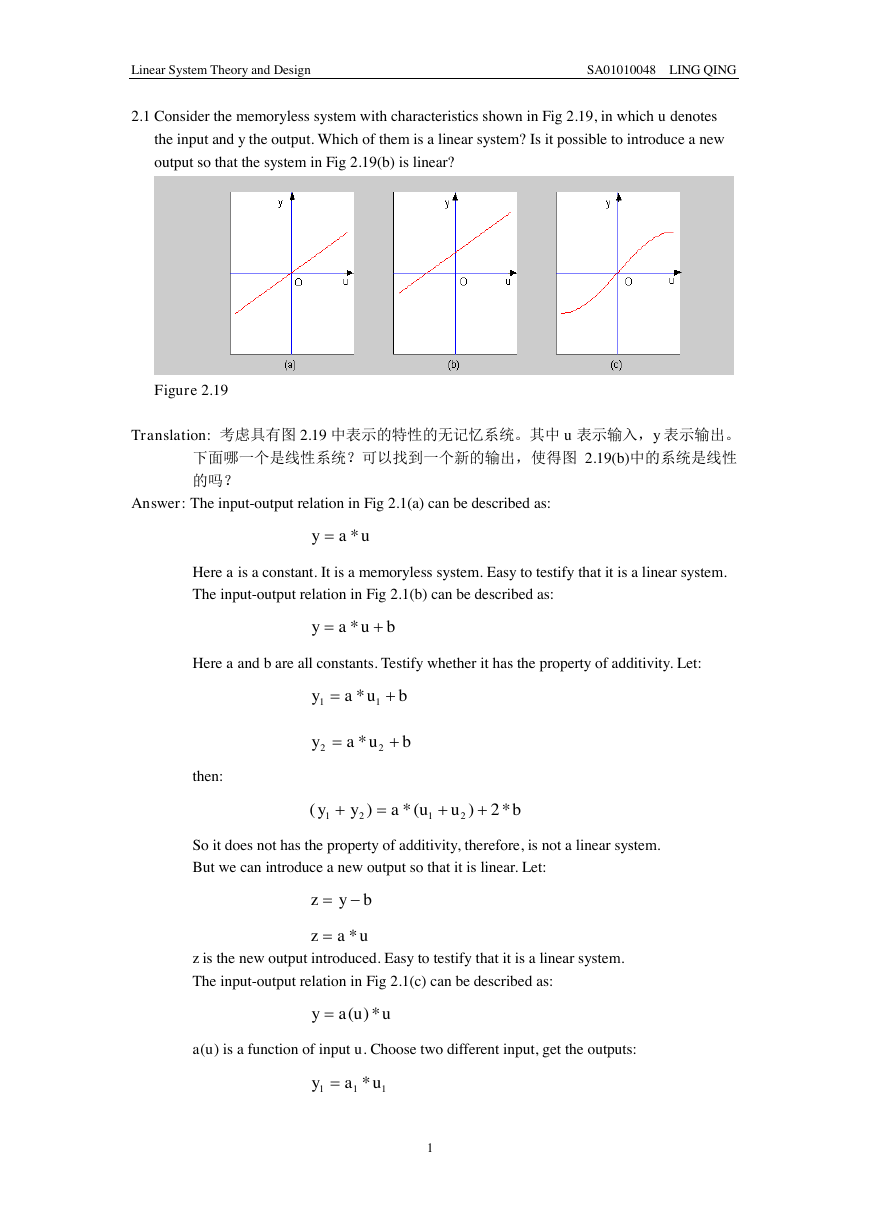
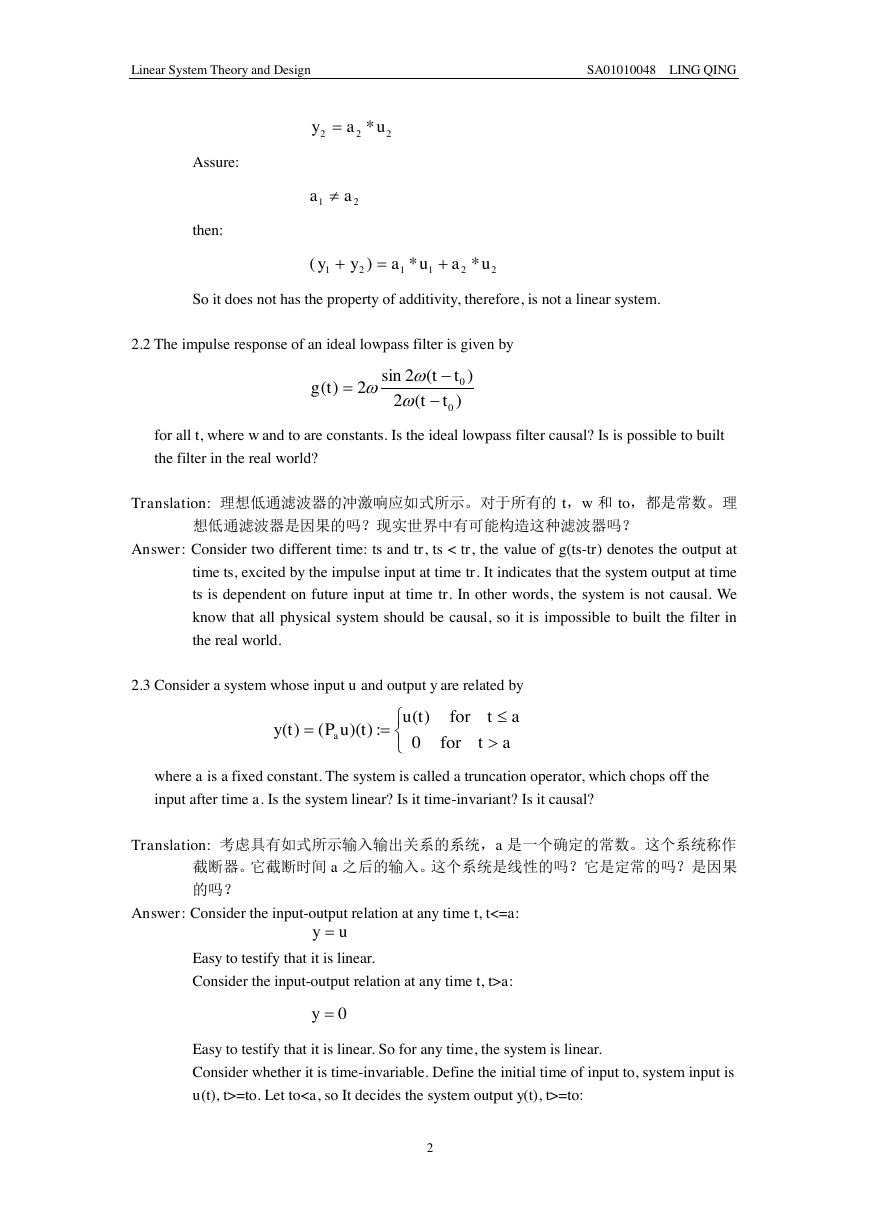
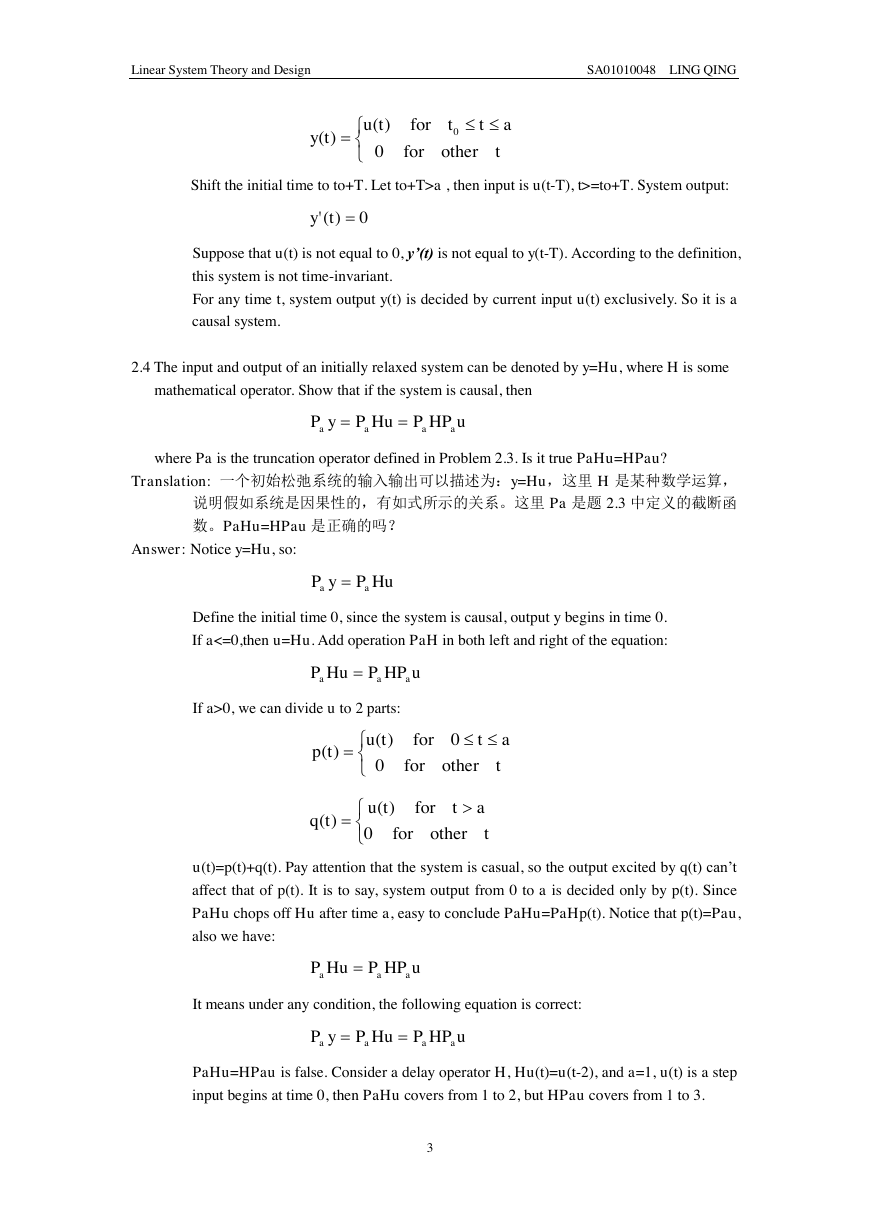
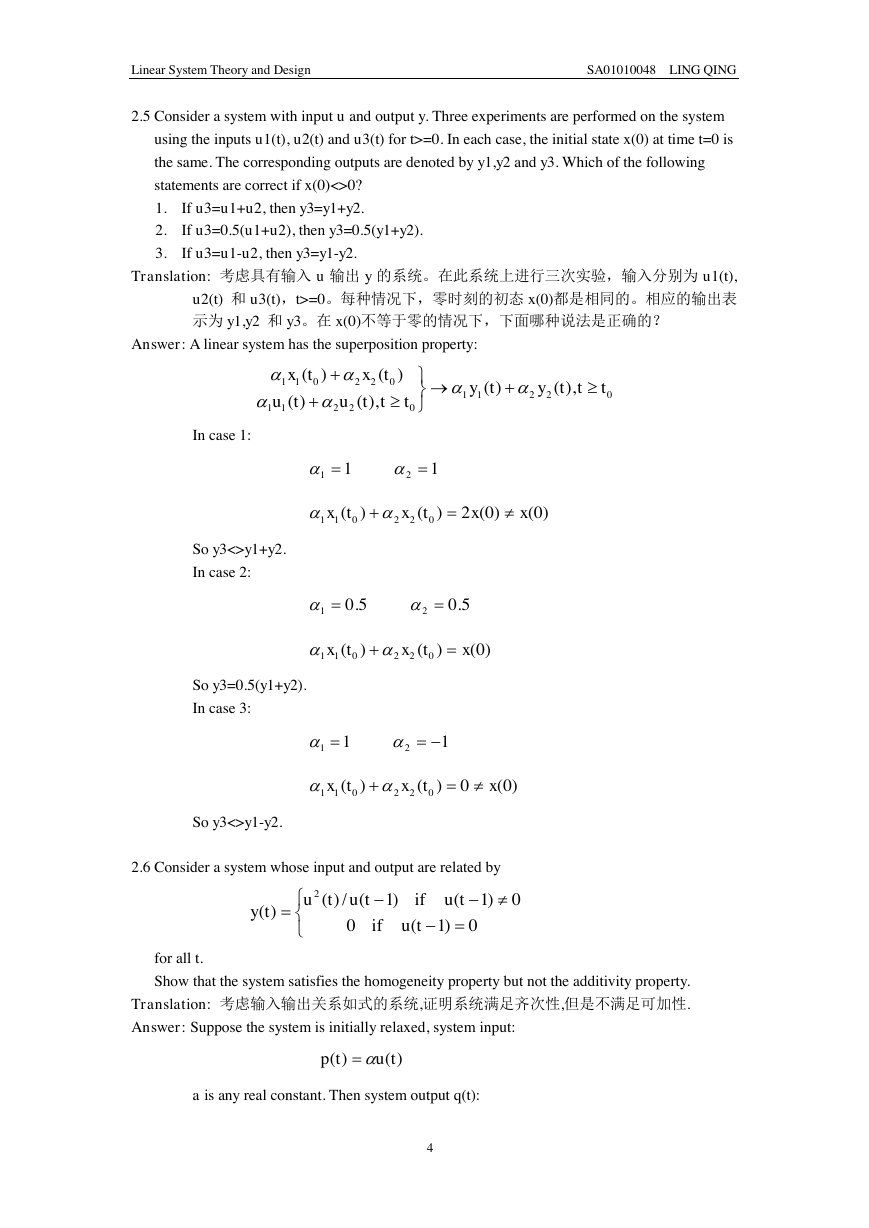
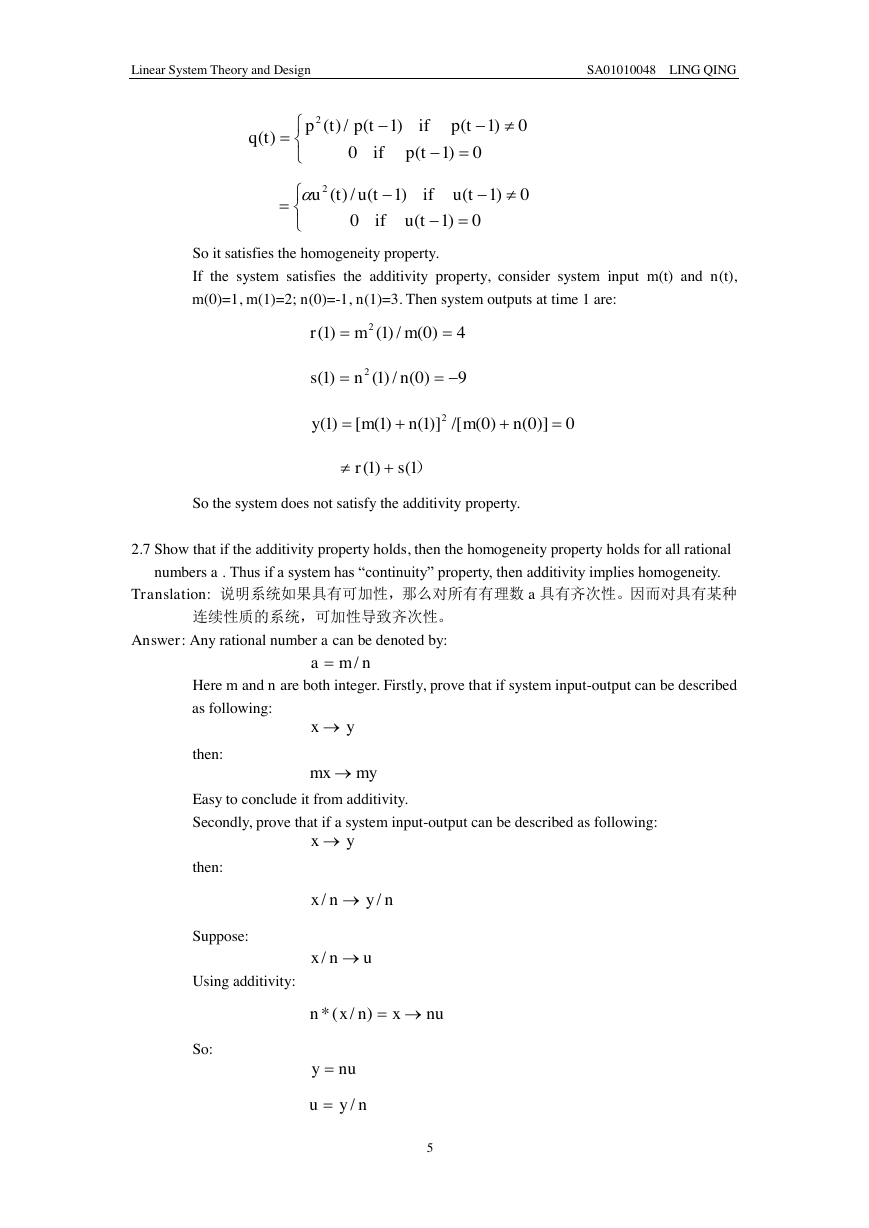
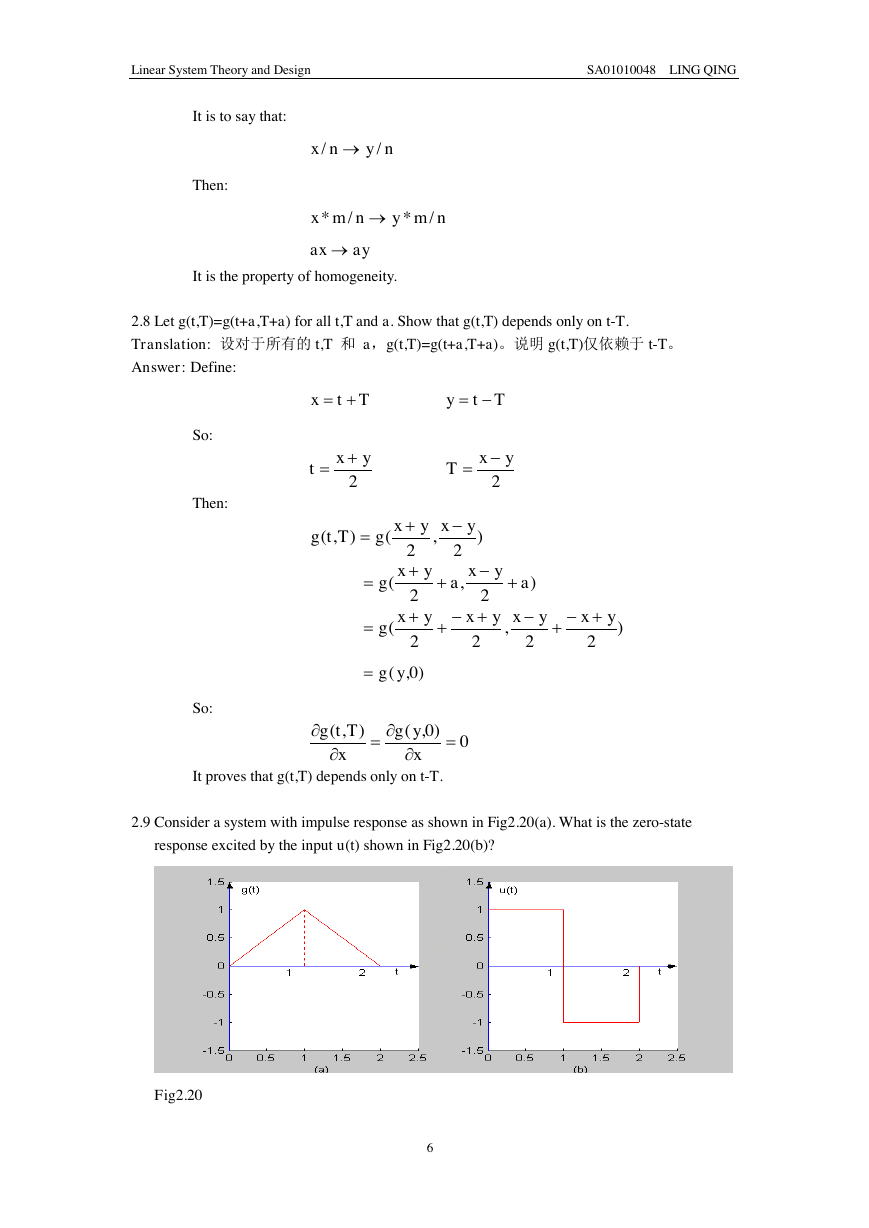
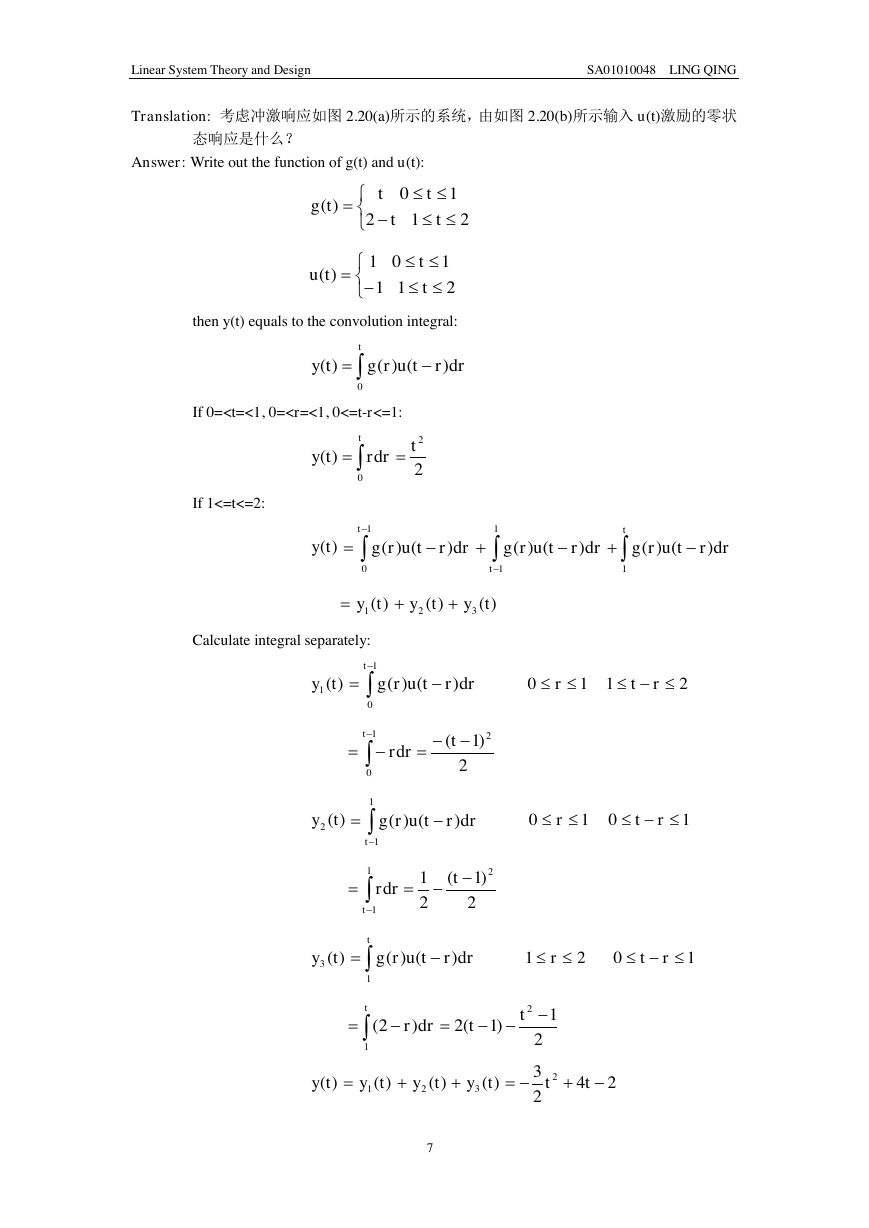








 2023年江西萍乡中考道德与法治真题及答案.doc
2023年江西萍乡中考道德与法治真题及答案.doc 2012年重庆南川中考生物真题及答案.doc
2012年重庆南川中考生物真题及答案.doc 2013年江西师范大学地理学综合及文艺理论基础考研真题.doc
2013年江西师范大学地理学综合及文艺理论基础考研真题.doc 2020年四川甘孜小升初语文真题及答案I卷.doc
2020年四川甘孜小升初语文真题及答案I卷.doc 2020年注册岩土工程师专业基础考试真题及答案.doc
2020年注册岩土工程师专业基础考试真题及答案.doc 2023-2024学年福建省厦门市九年级上学期数学月考试题及答案.doc
2023-2024学年福建省厦门市九年级上学期数学月考试题及答案.doc 2021-2022学年辽宁省沈阳市大东区九年级上学期语文期末试题及答案.doc
2021-2022学年辽宁省沈阳市大东区九年级上学期语文期末试题及答案.doc 2022-2023学年北京东城区初三第一学期物理期末试卷及答案.doc
2022-2023学年北京东城区初三第一学期物理期末试卷及答案.doc 2018上半年江西教师资格初中地理学科知识与教学能力真题及答案.doc
2018上半年江西教师资格初中地理学科知识与教学能力真题及答案.doc 2012年河北国家公务员申论考试真题及答案-省级.doc
2012年河北国家公务员申论考试真题及答案-省级.doc 2020-2021学年江苏省扬州市江都区邵樊片九年级上学期数学第一次质量检测试题及答案.doc
2020-2021学年江苏省扬州市江都区邵樊片九年级上学期数学第一次质量检测试题及答案.doc 2022下半年黑龙江教师资格证中学综合素质真题及答案.doc
2022下半年黑龙江教师资格证中学综合素质真题及答案.doc